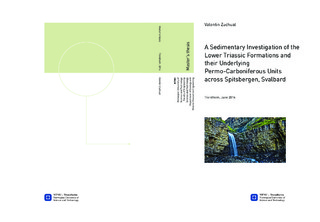| dc.description.abstract | This study documents and discusses the detailed sedimentology of the lowermost strata of the Triassic Vikinghøgda Fm. and Vardebukta Fm., and their underlying units, which belong (i) to the Permian Kapp Starostin Fm. in central and western Spitsbergen, and (ii) to the Lower Carboniferous Hornsundneset and Sergeevfjellet fms in south Spitsbergen.Together with a high-resolution sampling for further palynological and isotopic analysis purposes, nine detailed sedimentary sections have been measured and logged at Marmierfjellet, Høgskulefjellet, Kongressfjellet in central Spitsbergen, at Festningen in western Spitsbergen, and at Kovalevskajafjellet, Lidfjellet and Sergeevfjellet on the Sørkapp-Hornsund High. Logs and samples GPS coordinates have been recorded using the UTM 33x grid zone. Fossils and trace fossils have been determined and dated with the assistance of Prof. Hans Arne Nakrem (University of Oslo) and Nils-Martin Hanken (University of Tromsø). Based on the field data and the 19 targeted thin sections analyses, 17 sedimentary facies have been identified after sedimentary textures, structures and composition of the different rocks. They have been grouped into four facies associations, based on the vertical and lateral genetic relations of sedimentary facies, in order to determine and interpret their respective depositional environments, as follow: (i) Braided river, (ii) Cold offshore transition, (iii) Upper shoreface shallow marine and (iv) Warm water offshore transition.The topmost strata of the Kapp Starostin Fm. suggest a lateral shallowing-up trend within their depositional environment, with the appearance of storm-influenced beds and a lower spiculitic content towards the east. The boundary between the Kapp Starostin Fm. and the Vardebukta/Vikinghøgda fms, interpreted as a major transgressive event throughout the correlated sections of the arctic, shows no evidence of any break in the sedimentation, and display an unexpected apparent shallowing-up sequence, which contradicts the typical deepening-up scheme observed in text-book-like transgressive deposits. The occurrence of a fast transgression at the base of the Vardebukta/Vikinghøgda fms could explain the existence of such a sequence at this boundary. This study also shows the occurrence of major thickness variations within the Deltadalen Mb. between Marmierfjellet and Kongressfjellet in central Spitsbergen, which could be due to the existence of unmapped, low angle thrusts within the Triassic shales of the Vikinghøgda Fm.On the Sørkapp-Hornsund High, the conglomeratic Brevassfjellet Beds and the Myalina limestones of Dienerian age overlie (i) the Lower Carboniferous Hornsundneset Fm. at Lidfjellet, and (ii) the Sergeevfjellet Fm. at Sergeevfjellet and Kovalevskajafjellet. The soft shales of the Vardebukta Fm. cap these conglomeratic beds. Both Brevassfjellet Beds and Myalina limestones show both lateral and vertical differences in their internal architecture, as a consequence of spatial and temporal amplitude, and frequency variations of the flow energy. Also, this thesis suggests five amendments to the existing C13G geological map of the Hornsund area: (i) extension of the Hornsundneset Fm. to the boundary with the Triassic sediments at the foot of the northern ridge of Lidfjellet, (ii) the occurrence of the Sergeevfjellet Fm. between the Hornsundneset Fm. and the Brevassfjellet Beds on Kovalevskajafjellet, (iii) the relocation of the normal fault mapped on northern ridge of Sergeevfjellet to its southern ridge (iv) the mapping of a normal fault on Savičtoppen in the continuation of the normal fault existing on Sergeevfjellet, and (v) the existence of two unmapped thrusts on the western slopes of Sergeevfjellet. | nb_NO |

